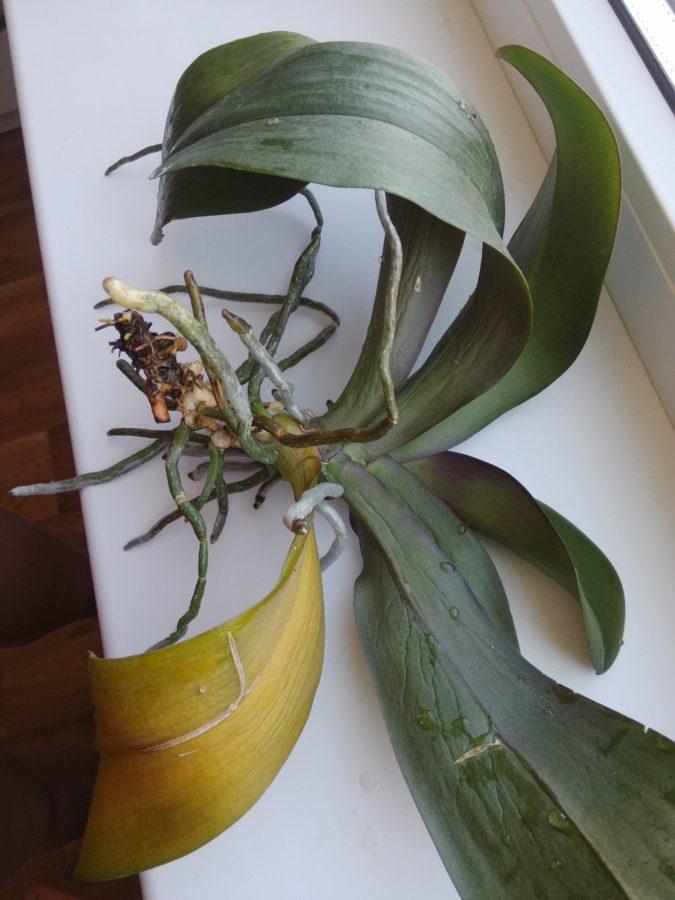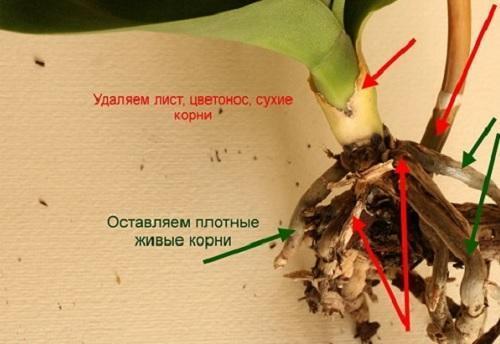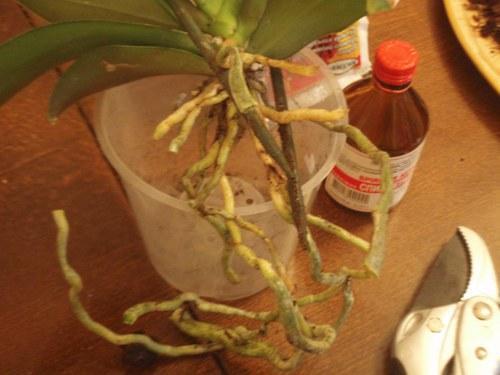How to save an orchid: resuscitation of a plant with rotten roots
 Hello! Can you please tell me what to do next with my orchid? Two months ago she moved to another place and after that she began to fade. The leaves shrivel and turn yellow, the peduncle has stopped growing. She took the orchid out of the pot and saw that all the roots were dry. Pruned, but there are aerial roots. What is the best course of action with her?
Hello! Can you please tell me what to do next with my orchid? Two months ago she moved to another place and after that she began to fade. The leaves shrivel and turn yellow, the peduncle has stopped growing. She took the orchid out of the pot and saw that all the roots were dry. Pruned, but there are aerial roots. What is the best course of action with her?Judging by the appearance of the orchid, the plant is already quite mature, moreover, its root system is thoroughly rotted. As a result, the leaves began to wilt and turn yellow, since the rotten roots are no longer able to provide them with moisture. However, it is quite possible to save the flower, because the upper part of the main root seems to be still alive. On closer inspection, dormant kidneys should be visible.
For orchid resuscitation it is necessary to carry out a number of manipulations:
- thoroughly clean the plant from rotten residues;
- process the flower;
- prepare the pot and substrate;
- plant an orchid.
Removing rotten parts of an orchid

Before replanting a flower, not only dried roots should be removed. The photo shows that the main root has also rotted - it is black. Using sharp scissors or a knife, cut off the entire blackened part of the root to the beginning of the living (green) tissue. You can only leave firm, elastic roots of a light color with a green tint.
Instruments must be disinfected before trimming.
The yellowed leaves also need to be removed: cut the leaf lengthwise with scissors and gently pull it in different directions at the base.
Orchid processing

After trimming the damaged tissues, rinse the remnants of the root system in a weak solution of potassium permanganate. Wipe the leaves themselves with a damp cloth soaked in the same solution. Then sprinkle all the places of the cuts with activated carbon. You can use regular cinnamon for this.
To stimulate root formation, experienced flower growers recommend soaking the roots of the plant before planting in a solution of the Epin preparation (1 drop per liter of water).
Now you need to let the orchid dry well. Drying time should be at least 3 hours, and even better, carry out all the preparatory work in the evening and leave the plant overnight. During this time, all moisture evaporates, including from hard-to-reach places, such as an outlet. In addition, the cuts will be slightly tightened.
Preparing the substrate and pot
If it is not possible to purchase a new pot, you can also use old utensils to plant the orchid. The pot should be thoroughly washed from the remaining substrate and rinsed with boiling water. Rinse plastic containers in a solution of potassium permanganate.
As for the substrate, it must first be sterilized by pouring boiling water over it. After this procedure, be sure to dry the bark.
Planting an orchid

Lay a drainage layer at the bottom of the pot - it will prevent the roots from rotting from stagnant water. Pour a little dried substrate on top and set an orchid on it. Arrange the aerial roots inside the pot. If there are extra long ones that do not fit in the flowerpot, you do not need to bend or break them forcibly. Let them stay on the surface. Cover the roots in the pot with the substrate.
To speed up the formation of new roots, put the flowerpot with the plant under a hood to avoid rapid evaporation of moisture and to maintain the same air temperature throughout the day. The first days it is enough to wipe the leaves with a damp sponge, watering is not necessary yet. In the future, watering is carried out as usual.
Hello! Is it possible to reanimate an orchid if the entire ground part disappeared, and after drying, the roots were placed in a new substrate ???
Is the growth point even alive? If the roots are dried and processed, and the growing point is alive, the plant has a chance to recover. I would try to save it, but the plant needs help. Wipe the upper live part with a solution of succinic acid so that the new leaf grows faster. Just wipe it down, don't spray it.
Phalaenopsis orchid, leaves rotted after flowering. The roots are practically healthy - green, gray-green, dense. in the middle of the coma - pink-lilac roots. What does the growth point look like?
You simply killed the plant by over-watering. There are some white dots on the roots. Perhaps these are pests. There are rotten roots, and the plant grew practically without soil in a cramped pot. Thanks to a strong root, the orchid can be saved. First, treat all the roots with a fungicide (you can use a manganese solution). Dry the roots well and remove the rotten ones. Plant the plant in sterilized orchid soil. Dry the soil spilled with boiling water. A healthy orchid may have light green or white roots. Green indicates humidity, while white indicates the need for watering. Growth points will appear at the top. To find them, it is necessary to carefully remove the dry remains of the leaf plates.
one more picture
Many thanks. I'll do it.
Only strange, I watered it by immersion for 20-40 minutes every 10 days or 2 weeks. And the rest of them feel fine ... The western window is light, there are no drafts ... The wet roots in the photo and the lack of soil - just because I soaked the lump and removed the bark as much as possible. The leaves on the diseased orchus seemed to be moldy from the inside. Maybe it was not good at removing moisture after spraying? But again, the rest do not suffer - see photo. White blooms a second time, pink, which is larger, with two branches, blooms a third time. the rest are donated this year. Ill, too, I was afraid to transplant her in bloom ... Or was it necessary?
In nurseries, special tablets are placed in the root of orchids to protect the plant. from orchid diseases and feed him. Over time, the tablet dissolves and disappears. The roots of a healthy orchid are always light green. The roots of an orchid requiring watering are white. Watering is necessary only when the orchid asks for it. The second mistake is spraying. I do not spray unless needed. I prefer to wipe the leaves with a solution of succinic acid. The advantage is that water never gets on the flowers and in the bowls of the leaf plates, which leads to their decay. A blooming orchid can be transferred to another container with the addition of fresh bark. Once again, the soil in nurseries is impregnated with special means, which makes it possible to sell you flowers in a beautiful form. Therefore, the crumbs have to be tamed and raised in their own conditions.
Hello!
The orchids have faded, the flower arrows are not dry and I have not cut them. After flowering, about one and a half months have passed and dormant buds on the arrows give new arrows with buds. Leave them and won't it drain the flower?
To leave or not is up to you, look at the general condition of the flower. I left my orchid last year. The flowering was no less abundant, and the plant itself did not suffer, after transplantation (this year) it has already grown 3 new leaves and releases a new peduncle.
the same orchid, other arrows
by the way, the leaf does not turn yellow, it is a reflection of light
Good day.I bought the rest of the orchid on sale. No roots.
Am I trying to get out of it right?
I cleaned the remnants of the roots. I did not cut anything and did not fall out. Held in a weak solution of potassium permanganate. Now every other day, a blend in warm water, I keep it in a solution of amber for 30 minutes, wipe the leaves with the same solution. Zat4m dry, remove excess moisture and send it with root. Then I will stir in the pot. There is a little expanded clay, pebbles and bark in the pot at the very bottom. I put the pot in a tray with a small amount of water and place it in a greenhouse. In the greenhouse, there is a pallet with pebbles and water, so I put a pot with a small pallet on it.
It seems that in 4 days she did not get any worse. I use warm boiled water.
Either you haven't cleaned your orchid enough, or it successfully continues to rot further. Do you see those black spots on the outlet and between the roots? This is all rot and if you do not remove it, it will grow and the flower will disappear, despite your concern. Plus, constant water procedures successfully help the development of the disease. It is necessary to thoroughly clean everything and remove to a healthy tissue, nothing wet and black should remain. Then sprinkle all wounds with crushed charcoal or activated charcoal and let dry well. Let the orchid lie (just not in the sun) for at least 5-6 hours, without water.
Then plant the flower in a bark substrate - the orchid still has its own remnants of living roots, so you don't need to keep it in water, this only promotes decay. It is also not necessary to put it on a tray with water so that the plant is constantly in contact with moisture. It is enough to use a special double pot for orchids, while the water from the second container must be drained after watering. The greenhouse (shelter from above) for the first time can be left, as well as regular rubbing of the leaves with succinic acid - it will help the orchid to recover faster.
Hello! Can this orchid be saved?
It seems that all the roots of your orchid have rotted, and even the rosette has begun to rot. Trim to living tissue and try rooting to build new roots. How to reanimate an orchid, detailed here https://myvilla.decorexpro.com/en/kak-reanimirovat-orhideyu/.
They presented an orchid, it bloomed, I transplanted it, after a week the flowers began to fall off, the branches on which the flowers were kept - dry, please tell me how to reanimate the orchid?
During flowering, replanting orchids, however, like other flowers, is not recommended. Only as a last resort, if she is sick, for example. Your plant may have responded in a similar way to the stress it received from the transplant. Or injury. If a couple of weeks have passed since this procedure, you can already try feeding her to boost her immunity and help her adapt. Succinic acid works well on orchids. It is sold in pharmacies as tablets. Wipe the leaves with the prepared solution. Should help.